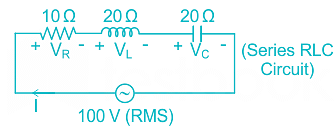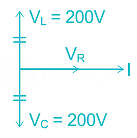Electronics and Communication Engineering (ECE) Exam > Electronics and Communication Engineering (ECE) Questions > A series RLC circuit consisting of R = 10 &Om...
Start Learning for Free
A series RLC circuit consisting of R = 10 Ω, XL = 20 Ω and XC = 20 Ω, is connected across an AC supply of 100 V (rms). The magnitude and pulse angle (with respect to supply voltage) of the voltage across the induction coil are respectively.
- a)400∠ - 90°V
- b)200∠ + 90°V
- c)200 ; ∠90°V
- d)400∠ + 90°V
Correct answer is option 'C'. Can you explain this answer?
| FREE This question is part of | Download PDF Attempt this Test |
Verified Answer
A series RLC circuit consisting of R = 10 Ω, XL= 20 Ω and ...
R = 10Ω, XL = 20 Ω, XC = 20 Ω
V = 100 V (RMS)

XL = XC = 20 Ω
This is the condition of resonance. Hence the circuit is purely Resistive.
Current (I) and applied voltage (V) are in phase and hence power factor will be unity.
I = V/R = 100∠0/10 = 10∠0 A
The voltage across the inductor, VL = I XL
= (10∠0) × (20∠90°)
= 200 ∠90° V
Magnitude of voltage, |VL| = 200 V
The phase of VL = 90°
Phasor diagram:

Most Upvoted Answer
A series RLC circuit consisting of R = 10 Ω, XL= 20 Ω and ...
Given information:
- R = 10 Ω (resistance)
- XL = 20 Ω (inductive reactance)
- XC = 200 Ω (capacitive reactance)
- Vrms = 200 V (rms voltage of the AC supply)
Key formulas:
- Impedance of the series RLC circuit: Z = √(R^2 + (XL - XC)^2)
- Voltage across the capacitor: Vc = Vrms * (XC / Z)
Solution:
Step 1: Calculate the impedance (Z) of the series RLC circuit.
Using the formula: Z = √(R^2 + (XL - XC)^2)
Substituting the given values: Z = √(10^2 + (20 - 200)^2)
Calculating: Z = √(100 + (-180)^2) = √(100 + 32400) = √32500 ≈ 180.277 Ω
Step 2: Calculate the voltage across the capacitor (Vc) using the formula:
Vc = Vrms * (XC / Z)
Substituting the given values: Vc = 200 * (200 / 180.277)
Calculating: Vc ≈ 200 * 1.109 ≈ 221.818 V
Since the question asks for the rms voltage across the capacitor, we need to convert the calculated voltage to rms.
The rms voltage across the capacitor is equal to the calculated voltage divided by the square root of 2 (1.414).
Therefore, Vrms_c = Vc / √2 ≈ 221.818 / 1.414 ≈ 156.977 V
Step 3: Answer the question:
The rms voltage across the capacitor is approximately 156.977 V. None of the given options match with this value, so none of the provided options are correct.
- R = 10 Ω (resistance)
- XL = 20 Ω (inductive reactance)
- XC = 200 Ω (capacitive reactance)
- Vrms = 200 V (rms voltage of the AC supply)
Key formulas:
- Impedance of the series RLC circuit: Z = √(R^2 + (XL - XC)^2)
- Voltage across the capacitor: Vc = Vrms * (XC / Z)
Solution:
Step 1: Calculate the impedance (Z) of the series RLC circuit.
Using the formula: Z = √(R^2 + (XL - XC)^2)
Substituting the given values: Z = √(10^2 + (20 - 200)^2)
Calculating: Z = √(100 + (-180)^2) = √(100 + 32400) = √32500 ≈ 180.277 Ω
Step 2: Calculate the voltage across the capacitor (Vc) using the formula:
Vc = Vrms * (XC / Z)
Substituting the given values: Vc = 200 * (200 / 180.277)
Calculating: Vc ≈ 200 * 1.109 ≈ 221.818 V
Since the question asks for the rms voltage across the capacitor, we need to convert the calculated voltage to rms.
The rms voltage across the capacitor is equal to the calculated voltage divided by the square root of 2 (1.414).
Therefore, Vrms_c = Vc / √2 ≈ 221.818 / 1.414 ≈ 156.977 V
Step 3: Answer the question:
The rms voltage across the capacitor is approximately 156.977 V. None of the given options match with this value, so none of the provided options are correct.
Attention Electronics and Communication Engineering (ECE) Students!
To make sure you are not studying endlessly, EduRev has designed Electronics and Communication Engineering (ECE) study material, with Structured Courses, Videos, & Test Series. Plus get personalized analysis, doubt solving and improvement plans to achieve a great score in Electronics and Communication Engineering (ECE).

|
Explore Courses for Electronics and Communication Engineering (ECE) exam
|

|
Similar Electronics and Communication Engineering (ECE) Doubts
A series RLC circuit consisting of R = 10 Ω, XL= 20 Ω and XC= 20 Ω, is connected across an AC supply of 100 V (rms). The magnitude and pulse angle (with respect to supply voltage) of the voltage across the induction coil are respectively.a)400∠ - 90°V b)200∠ + 90°Vc)200 ; ∠90°V d)400∠ + 90°VCorrect answer is option 'C'. Can you explain this answer?
Question Description
A series RLC circuit consisting of R = 10 Ω, XL= 20 Ω and XC= 20 Ω, is connected across an AC supply of 100 V (rms). The magnitude and pulse angle (with respect to supply voltage) of the voltage across the induction coil are respectively.a)400∠ - 90°V b)200∠ + 90°Vc)200 ; ∠90°V d)400∠ + 90°VCorrect answer is option 'C'. Can you explain this answer? for Electronics and Communication Engineering (ECE) 2024 is part of Electronics and Communication Engineering (ECE) preparation. The Question and answers have been prepared according to the Electronics and Communication Engineering (ECE) exam syllabus. Information about A series RLC circuit consisting of R = 10 Ω, XL= 20 Ω and XC= 20 Ω, is connected across an AC supply of 100 V (rms). The magnitude and pulse angle (with respect to supply voltage) of the voltage across the induction coil are respectively.a)400∠ - 90°V b)200∠ + 90°Vc)200 ; ∠90°V d)400∠ + 90°VCorrect answer is option 'C'. Can you explain this answer? covers all topics & solutions for Electronics and Communication Engineering (ECE) 2024 Exam. Find important definitions, questions, meanings, examples, exercises and tests below for A series RLC circuit consisting of R = 10 Ω, XL= 20 Ω and XC= 20 Ω, is connected across an AC supply of 100 V (rms). The magnitude and pulse angle (with respect to supply voltage) of the voltage across the induction coil are respectively.a)400∠ - 90°V b)200∠ + 90°Vc)200 ; ∠90°V d)400∠ + 90°VCorrect answer is option 'C'. Can you explain this answer?.
A series RLC circuit consisting of R = 10 Ω, XL= 20 Ω and XC= 20 Ω, is connected across an AC supply of 100 V (rms). The magnitude and pulse angle (with respect to supply voltage) of the voltage across the induction coil are respectively.a)400∠ - 90°V b)200∠ + 90°Vc)200 ; ∠90°V d)400∠ + 90°VCorrect answer is option 'C'. Can you explain this answer? for Electronics and Communication Engineering (ECE) 2024 is part of Electronics and Communication Engineering (ECE) preparation. The Question and answers have been prepared according to the Electronics and Communication Engineering (ECE) exam syllabus. Information about A series RLC circuit consisting of R = 10 Ω, XL= 20 Ω and XC= 20 Ω, is connected across an AC supply of 100 V (rms). The magnitude and pulse angle (with respect to supply voltage) of the voltage across the induction coil are respectively.a)400∠ - 90°V b)200∠ + 90°Vc)200 ; ∠90°V d)400∠ + 90°VCorrect answer is option 'C'. Can you explain this answer? covers all topics & solutions for Electronics and Communication Engineering (ECE) 2024 Exam. Find important definitions, questions, meanings, examples, exercises and tests below for A series RLC circuit consisting of R = 10 Ω, XL= 20 Ω and XC= 20 Ω, is connected across an AC supply of 100 V (rms). The magnitude and pulse angle (with respect to supply voltage) of the voltage across the induction coil are respectively.a)400∠ - 90°V b)200∠ + 90°Vc)200 ; ∠90°V d)400∠ + 90°VCorrect answer is option 'C'. Can you explain this answer?.
Solutions for A series RLC circuit consisting of R = 10 Ω, XL= 20 Ω and XC= 20 Ω, is connected across an AC supply of 100 V (rms). The magnitude and pulse angle (with respect to supply voltage) of the voltage across the induction coil are respectively.a)400∠ - 90°V b)200∠ + 90°Vc)200 ; ∠90°V d)400∠ + 90°VCorrect answer is option 'C'. Can you explain this answer? in English & in Hindi are available as part of our courses for Electronics and Communication Engineering (ECE).
Download more important topics, notes, lectures and mock test series for Electronics and Communication Engineering (ECE) Exam by signing up for free.
Here you can find the meaning of A series RLC circuit consisting of R = 10 Ω, XL= 20 Ω and XC= 20 Ω, is connected across an AC supply of 100 V (rms). The magnitude and pulse angle (with respect to supply voltage) of the voltage across the induction coil are respectively.a)400∠ - 90°V b)200∠ + 90°Vc)200 ; ∠90°V d)400∠ + 90°VCorrect answer is option 'C'. Can you explain this answer? defined & explained in the simplest way possible. Besides giving the explanation of
A series RLC circuit consisting of R = 10 Ω, XL= 20 Ω and XC= 20 Ω, is connected across an AC supply of 100 V (rms). The magnitude and pulse angle (with respect to supply voltage) of the voltage across the induction coil are respectively.a)400∠ - 90°V b)200∠ + 90°Vc)200 ; ∠90°V d)400∠ + 90°VCorrect answer is option 'C'. Can you explain this answer?, a detailed solution for A series RLC circuit consisting of R = 10 Ω, XL= 20 Ω and XC= 20 Ω, is connected across an AC supply of 100 V (rms). The magnitude and pulse angle (with respect to supply voltage) of the voltage across the induction coil are respectively.a)400∠ - 90°V b)200∠ + 90°Vc)200 ; ∠90°V d)400∠ + 90°VCorrect answer is option 'C'. Can you explain this answer? has been provided alongside types of A series RLC circuit consisting of R = 10 Ω, XL= 20 Ω and XC= 20 Ω, is connected across an AC supply of 100 V (rms). The magnitude and pulse angle (with respect to supply voltage) of the voltage across the induction coil are respectively.a)400∠ - 90°V b)200∠ + 90°Vc)200 ; ∠90°V d)400∠ + 90°VCorrect answer is option 'C'. Can you explain this answer? theory, EduRev gives you an
ample number of questions to practice A series RLC circuit consisting of R = 10 Ω, XL= 20 Ω and XC= 20 Ω, is connected across an AC supply of 100 V (rms). The magnitude and pulse angle (with respect to supply voltage) of the voltage across the induction coil are respectively.a)400∠ - 90°V b)200∠ + 90°Vc)200 ; ∠90°V d)400∠ + 90°VCorrect answer is option 'C'. Can you explain this answer? tests, examples and also practice Electronics and Communication Engineering (ECE) tests.

|
Explore Courses for Electronics and Communication Engineering (ECE) exam
|

|
Suggested Free Tests
Signup for Free!
Signup to see your scores go up within 7 days! Learn & Practice with 1000+ FREE Notes, Videos & Tests.
























